Impact of CoCrFeNiMo High-Entropy-Alloy Doping on the Mechanical and Electrochemical Properties of B4C Ceramic
Abstract
1. Introduction
2. Materials and Methods
2.1. Material Preparation
2.2. Scanning Electron Microscopy (SEM)
2.3. Electrochemical Tests
2.3.1. Corrosion Potential
2.3.2. Corrosion Rate
2.3.3. Electrochemical Impedance Spectroscopy (EIS)
2.4. Microhardness
3. Results
3.1. Scanning Electron Microscope (SEM)
3.2. Electrochemical Tests
3.2.1. Corrosion Potential
3.2.2. Corrosion Rate
3.2.3. Electrochemical Impedance Spectroscopy (EIS)
3.3. Microhardness
4. Conclusions
- When CoCrFeNiMo high-entropy alloy is added to the B4C ceramic matrix, a denser structure is obtained. A more refined grain structure was obtained because of this doping procedure. HEA addition leads to a more compact configuration and the inhibition of grain expansion in comparison to monolithic B4C, resulting in notable microstructure alterations. Of all the samples studied, the smaller average grain size and the denser configuration were achieved in the 2% HEA concentration sample.
- Electrochemical tests revealed that corrosion resistance improved progressively with higher HEA content. The 3% HEA-doped B4C demonstrates the highest resistance in artificial seawater conditions. The enhanced performance is attributed to the formation of a more compact and protective passive layer, effectively mitigating material corrosion.
- The statistical microhardness analysis of all composites revealed that even though every sample followed a normal distribution (suggesting a homogeneous structure), the 0.5% and 3% HEA concentrations had a less uniform and predictable hardness distribution, which suggests ongoing microstructural adjustments. The Vickers hardness of the B4C-doped composites were higher as the HEA percentage increased, indicating a strict relation between doping and hardness.
Author Contributions
Funding
Institutional Review Board Statement
Informed Consent Statement
Data Availability Statement
Acknowledgments
Conflicts of Interest
References
- Yavas, B.; Sahin, F.; Yucel, O.; Goller, G. Effect of Particle Size, Heating Rate and CNT Addition on Densification, Microstructure and Mechanical Properties of B4C Ceramics. Ceram. Int. 2015, 41, 8936–8944. [Google Scholar] [CrossRef]
- Domnich, V.; Reynaud, S.; Haber, R.A.; Chhowalla, M. Boron Carbide: Structure, Properties, and Stability under Stress. J. Am. Ceram. Soc. 2011, 94, 3605–3628. [Google Scholar] [CrossRef]
- Suri, A.K.; Subramanian, C.; Sonber, J.K.; Ch Murthy, T.S.R. Synthesis and Consolidation of Boron Carbide: A Review. Int. Mater. Rev. 2010, 55, 4–38. [Google Scholar] [CrossRef]
- Pérez, S.; Tamayo, P.; Rico, J.; Alonso, J.; Thomas, C. Effect of Fibers and Boron Carbide on the Radiation Shielding Properties of Limestone and Magnetite Aggregate Concrete. Prog. Nucl. Energy 2024, 175, 105320. [Google Scholar] [CrossRef]
- Tamayo, P.; Thomas, C.; Rico, J.; Pérez, S.; Mañanes, A. Radiation Shielding Properties of Siderurgical Aggregate Concrete. Constr. Build. Mater. 2022, 319, 126098. [Google Scholar] [CrossRef]
- Zhang, W. A Review of Tribological Properties for Boron Carbide Ceramics. Prog. Mater. Sci. 2021, 116, 100718. [Google Scholar] [CrossRef]
- Zorzi, J.E.; Perottoni, C.A.; Da Jornada, J.A.H. Hardness and Wear Resistance of B4C Ceramics Prepared with Several Additives. Mater. Lett. 2005, 59, 2932–2935. [Google Scholar] [CrossRef]
- Cantor, B.; Chang, I.T.H.; Knight, P.; Vincent, A.J.B. Microstructural Development in Equiatomic Multicomponent Alloys. Mater. Sci. Eng. 2004, 375, 213–218. [Google Scholar] [CrossRef]
- Yeh, J.W. Recent Progress in High-Entropy Alloys. Ann. Chim. Sci. Mater. 2006, 31, 633–648. [Google Scholar] [CrossRef]
- Kozhakhmetov, Y.; Skakov, M.; Kurbanbekov, S.; Uazyrkhanova, G.; Kurmantayev, A.; Kizatov, A.; Mussakhan, N. High-Entropy Alloys: Innovative Materials with Unique Properties for Hydrogen Storage and Technologies for Their Production. Metals 2025, 15, 100. [Google Scholar] [CrossRef]
- de Oliveira, T.G.; Fagundes, D.V.; Capellato, P.; Sachs, D.; da Silva, A.A.A.P. A Review of Biomaterials Based on High-Entropy Alloys. Metals 2022, 12, 1940. [Google Scholar] [CrossRef]
- Castro, D.; Jaeger, P.; Baptista, A.C.; Oliveira, J.P. An Overview of High-entropy Alloys as Biomaterials. Metals 2021, 11, 648. [Google Scholar] [CrossRef]
- Gawel, R.; Rogal, Ł.; Smoła, G.; Grzesik, Z. High-Temperature Oxidation and Diffusion Studies on Selected Al–Cr–Fe–Ni High-Entropy Alloys for Potential Application in Thermal Barrier Coatings. Intermetallics 2024, 169, 108273. [Google Scholar] [CrossRef]
- Yang, H.; Shao, Z.; Lu, Q.; Cui, C.; Xu, L.; Yang, G. Development of Reduced-Activation and Radiation-Resistant High-Entropy Alloys for Fusion Reactor. Int. J. Refract. Met. Hard Mater. 2024, 121, 106674. [Google Scholar] [CrossRef]
- Chakraborty, P.; Sarkar, A.; Ali, K.; Jha, J.; Jothilakshmi, N.; Arya, A.; Tewari, R. Design and Development of Low Density, High Strength ZrNbAlVTi High Entropy Alloy for High Temperature Applications. Int. J. Refract. Met. Hard Mater. 2023, 113, 106222. [Google Scholar] [CrossRef]
- Xu, Z.Q.; Ma, Z.L.; Wang, M.; Chen, Y.W.; Tan, Y.D.; Cheng, X.W. Design of Novel Low-Density Refractory High Entropy Alloys for High-Temperature Applications. Mater. Sci. Eng. 2019, 755, 318–322. [Google Scholar] [CrossRef]
- Nartita, R.; Ionita, D.; Demetrescu, I. A Modern Approach to HEAs: From Structure to Properties and Potential Applications. Crystals 2024, 14, 451. [Google Scholar] [CrossRef]
- Naveen, L.; Umre, P.; Chakraborty, P.; Rahul, M.R.; Samal, S.; Tewari, R. Development of Single-Phase BCC Refractory High Entropy Alloys Using Machine Learning Techniques. Comput. Mater. Sci. 2024, 238, 112917. [Google Scholar] [CrossRef]
- Wakai, E.; Noto, H.; Shibayama, T.; Furuya, K.; Ando, M.; Kamada, T.; Ishida, T.; Makimura, S. Microstructures and Hardness of BCC Phase Iron-Based High Entropy Alloy Fe-Mn-Cr-V-Al-C. Mater. Charact. 2024, 211, 113881. [Google Scholar] [CrossRef]
- Li, C.; Ma, Z.; Tong, S.; Liu, J.; Zhang, W.; Shen, G.; Wang, S.; Zhao, H.; Ren, L. Mechanical-Thermal Coupling Fatigue Failure of CoCrFeMnNi High Entropy Alloy. J. Mater. Res. Technol. 2024, 30, 3430–3437. [Google Scholar] [CrossRef]
- Matsuzaka, T.; Hyakubu, A.; Kim, Y.S.; Matsugaki, A.; Nagase, T.; Ishimoto, T.; Ozasa, R.; Kim, H.S.; Mizuguchi, T.; Gokcekaya, O.; et al. Development of an Equiatomic Octonary TiNbTaZrMoHfWCr Super-High-Entropy Alloy for Biomedical Applications. Mater. Chem. Phys. 2024, 316, 129120. [Google Scholar] [CrossRef]
- Wu, Y.; Du, C.; Yu, Z.; Wang, R.; Ren, X. Effect of Cu Content on the Microstructure and Mechanical Properties of Fe20Co30Ni10Cr20Mn20 FCC-Typed HEAs. Mater. Sci. Eng. 2024, 897, 146336. [Google Scholar] [CrossRef]
- Yen, C.C.; Lin, S.Y.; Ting, C.L.; Tsai, T.L.; Chen, Y.T.; Yen, S.K. Passivation Mechanisms of CoCrFeNiMox (x = 0, 0.1, 0.2, 0.3) High Entropy Alloys and MP35N in 3.5 Wt% NaCl Aerated Aqueous Solutions. Corros. Sci. 2024, 228, 111812. [Google Scholar] [CrossRef]
- Dong, D.; Jiang, W.; Wang, X.; Ma, T.; Zhu, D.; Wang, Y.; Huo, J. Enhanced Mechanical Properties of High Pressure Solidified CoCrFeNiMo0.3 High Entropy Alloy via Nano-Precipitated Phase. Intermetallics 2024, 166, 108192. [Google Scholar] [CrossRef]
- Zin, V.; Montagner, F.; Miorin, E.; Mortalò, C.; Tinazzi, R.; Bolelli, G.; Lusvarghi, L.; Togni, A.; Frabboni, S.; Gazzadi, G.; et al. Effect of Mo Content on the Microstructure and Mechanical Properties of CoCrFeNiMox HEA Coatings Deposited by High Power Impulse Magnetron Sputtering. Surf. Coat. Technol. 2024, 476, 130244. [Google Scholar] [CrossRef]
- Guo, K.; Sun, Y.; Cheng, W.; Gu, J.; Chen, Y.; Zhang, S. Effect of Rare Earth La2O3 on the Microstructure and Corrosion Resistance of CoCrFeNiMoSi High Entropy Alloys. Surf. Interfaces 2024, 44, 103683. [Google Scholar] [CrossRef]
- Brito-Garcia, S.; Mirza-Rosca, J.; Geanta, V.; Voiculescu, I. Mechanical and Corrosion Behavior of Zr-Doped High-Entropy Alloy from CoCrFeMoNi System. Materials 2023, 16, 1832. [Google Scholar] [CrossRef]
- Semikolenov, A.; Shalnova, S.; Klinkov, V.; Andreeva, V.; Salynova, M.; Larionova, T.; Tolochko, O. Effect of al Content on Phase Compositions of FeNiCoCrMo0.5AlxHigh Entropy Alloy. Metals 2021, 11, 1734. [Google Scholar] [CrossRef]
- Brito-García, S.; Jiménez-Marcos, C.; Mirza-Rosca, J.; Voiculescu, I. Behavior of Ti-Doped CoCrFeMoNi High Entropy Alloy. Microsc. Microanal. 2023, 29, 439–444. [Google Scholar] [CrossRef]
- Li, Y.; Zhang, J.; Huang, X.; Liu, J.; Deng, L.; Han, P. Influence of Laser Power on Microstructure Evolution and Properties of Laser Cladded FeNiCoCrMo HEA Coatings. Mater. Today Commun. 2023, 35, 105615. [Google Scholar] [CrossRef]
- Wu, H.; Zhang, S.; Wang, Z.Y.; Zhang, C.H.; Chen, H.T.; Chen, J. New Studies on Wear and Corrosion Behavior of Laser Cladding FeNiCoCrMox High Entropy Alloy Coating: The Role of Mo. Int. J. Refract. Metals. Hard. Mater. 2022, 102, 105721. [Google Scholar] [CrossRef]
- Wang, W.; Wang, J.; Sun, Z.; Li, J.; Li, L.; Song, X.; Wen, X.; Xie, L.; Yang, X. Effect of Mo and Aging Temperature on Corrosion Behavior of (CoCrFeNi)100-XMox High-Entropy Alloys. J. Alloys Compd 2020, 812, 152139. [Google Scholar] [CrossRef]
- Fu, Y.; Huang, C.; Du, C.; Li, J.; Dai, C.; Luo, H.; Liu, Z.; Li, X. Evolution in Microstructure, Wear, Corrosion, and Tribocorrosion Behavior of Mo-Containing High-Entropy Alloy Coatings Fabricated by Laser Cladding. Corros. Sci. 2021, 191, 109727. [Google Scholar] [CrossRef]
- Dai, C.; Luo, H.; Li, J.; Du, C.; Liu, Z.; Yao, J. X-Ray Photoelectron Spectroscopy and Electrochemical Investigation of the Passive Behavior of High-Entropy FeCoCrNiMox Alloys in Sulfuric Acid. Appl. Surf. Sci. 2020, 499, 143903. [Google Scholar] [CrossRef]
- Wang, L.; Mercier, D.; Zanna, S.; Seyeux, A.; Laurent-Brocq, M.; Perrière, L.; Guillot, I.; Marcus, P. Study of the Surface Oxides and Corrosion Behaviour of an Equiatomic CoCrFeMnNi High Entropy Alloy by XPS and ToF-SIMS. Corros. Sci. 2020, 167, 108507. [Google Scholar] [CrossRef]
- Rico-Cano, A.D.; Mirza-Rosca, J.C.; Ocak, B.C.; Goller, G. Corrosion Behavior and Microhardness of a New B4C Ceramic Doped with 3% Volume High-Entropy Alloy in an Aggressive Environment. Metals 2025, 15, 79. [Google Scholar] [CrossRef]
- Rico-Cano, A.D.; Mirza-Rosca, J.C.; Ocak, B.C.; Goller, G. Corrosion Behavior of New B4C Ceramic Doped with High-Entropy Alloy in an Aggressive Environment. Microsc. Microanal. 2024, 30, ozae044.666. [Google Scholar] [CrossRef]
- ASTM E112-96; Standard Test Methods for Determining Average Grain Size. ASTM International: West Conshohocken, PA, USA, 2004.
- ASTM G5-94; Standard Reference Test Method for Making Potentiostatic and Potentiodynamic Anodic Polarization Measurements. ASTM: West Conshohocken, PA, USA, 2004.
- ASTM G5-87; Recommended Practice for Making Potentiostatic and Potentiodynamic Polarization Measurements, Annual Book of Standards. ASTM International: West Conshohocken, PA, USA, 2002.
- ISO 16773-1-4:2016; Electrochemical Impedance Spectroscopy (EIS) on Coated and Uncoated Metallic Specimens n.d. ISO: Geneva, Switzerland, 2016.
- ISO 14577-1:2015; Metallic Materials—Instrumented Indentation Test for Hardness and Materials Parameters—Part 1: Test Method n.d. ISO: Geneva, Switzerland, 2015.
- German, R.M.; Suri, P.; Park, S.J. Review: Liquid Phase Sintering. J. Mater. Sci. 2009, 44, 1–39. [Google Scholar] [CrossRef]
- Wagner, C.; Traud, W. “On the Interpretation of Corrosion Processes through the Superposition of Electrochemical Partial Processes and on the Potential of Mixed Electrodes,” with a Perspective by F. Mansfeld. Corrosion 2006, 62, 843. [Google Scholar]
- Xu, M.; Zheng, Z.; Han, D.; Ma, R.; Du, A.; Fan, Y.; Zhao, X.; Cao, X. Improvement of Cracking Resistance of Hot-Dip Zn-Al-Mg Coatings by Heat Treatment. Mater. Today Commun. 2023, 36, 106521. [Google Scholar] [CrossRef]
- Wang, J.; Han, D.; Qiao, Z.; Zheng, Z.; Ma, R.; Du, A.; Fan, Y.; Zhao, X.; Yu, H.; Cao, X. Study on the Microstructure and Corrosion Resistance of Hot-Dip Al-Zn-Si-XMg Coating. Surf. Coat. Technol. 2025, 496, 131654. [Google Scholar] [CrossRef]
- Uzun, A.; Asikuzun, E.; Gokmen, U.; Cinici, H. Vickers Microhardness Studies on B4C Reinforced/Unreinforced Foamable Aluminium Composites. Trans. Indian Inst. Met. 2018, 71, 327–337. [Google Scholar] [CrossRef]
- Cramer, C.L.; Cakmak, E.; Unocic, K.A. Hardness Measurements and Interface Behavior of SiC-B4C-Si Multiple Phase Particulate Composites Made with Melt Infiltration and Additive Manufacturing. J. Compos. Sci. 2023, 7, 172. [Google Scholar] [CrossRef]
- Ma, H.; Liang, Y.; Fu, H. Effect of B4C Addition on Microstructure and Wear Resistance of Laser Cladding NiCrBSi Coatings. JOM 2023, 75, 515–525. [Google Scholar] [CrossRef]
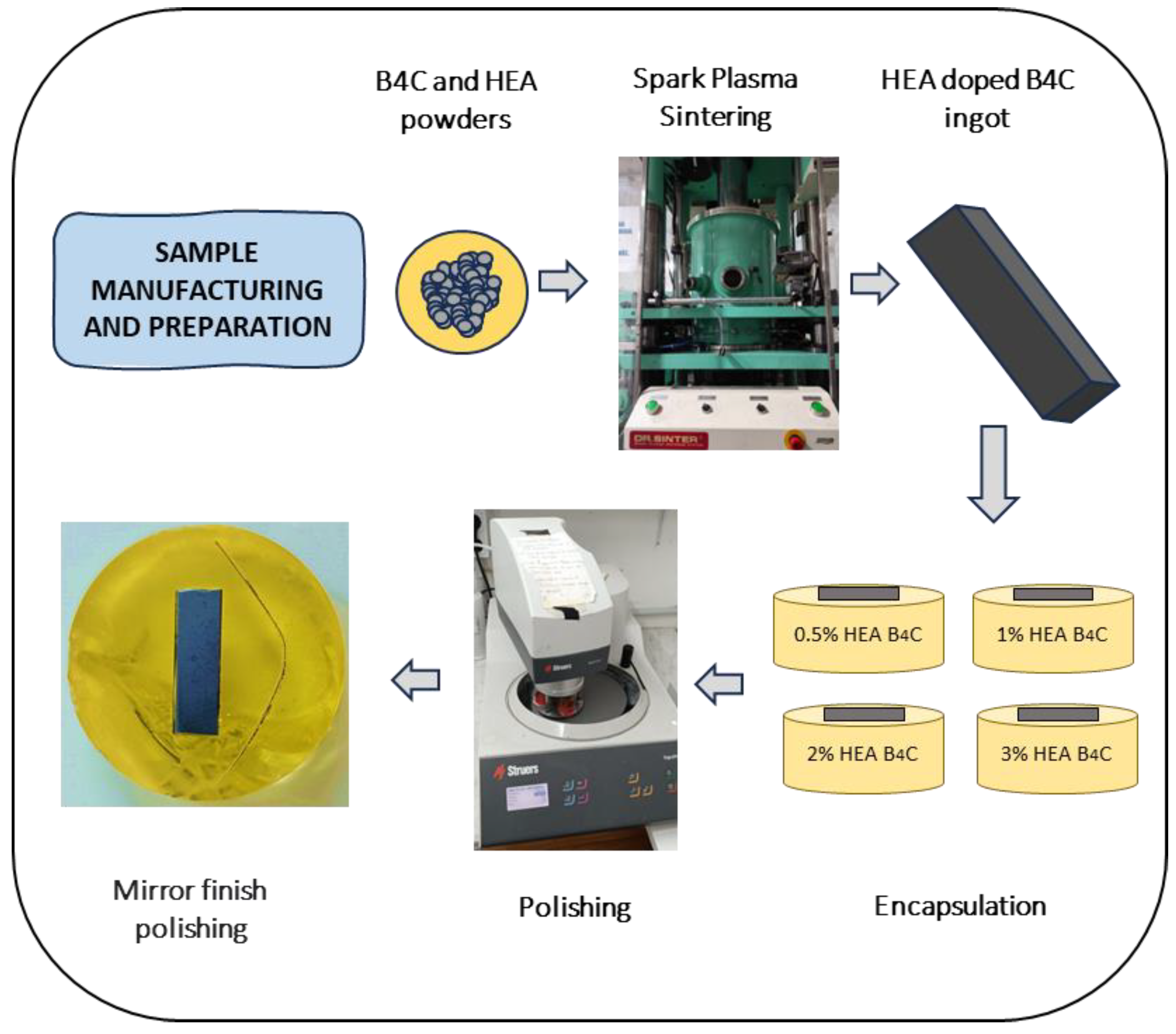

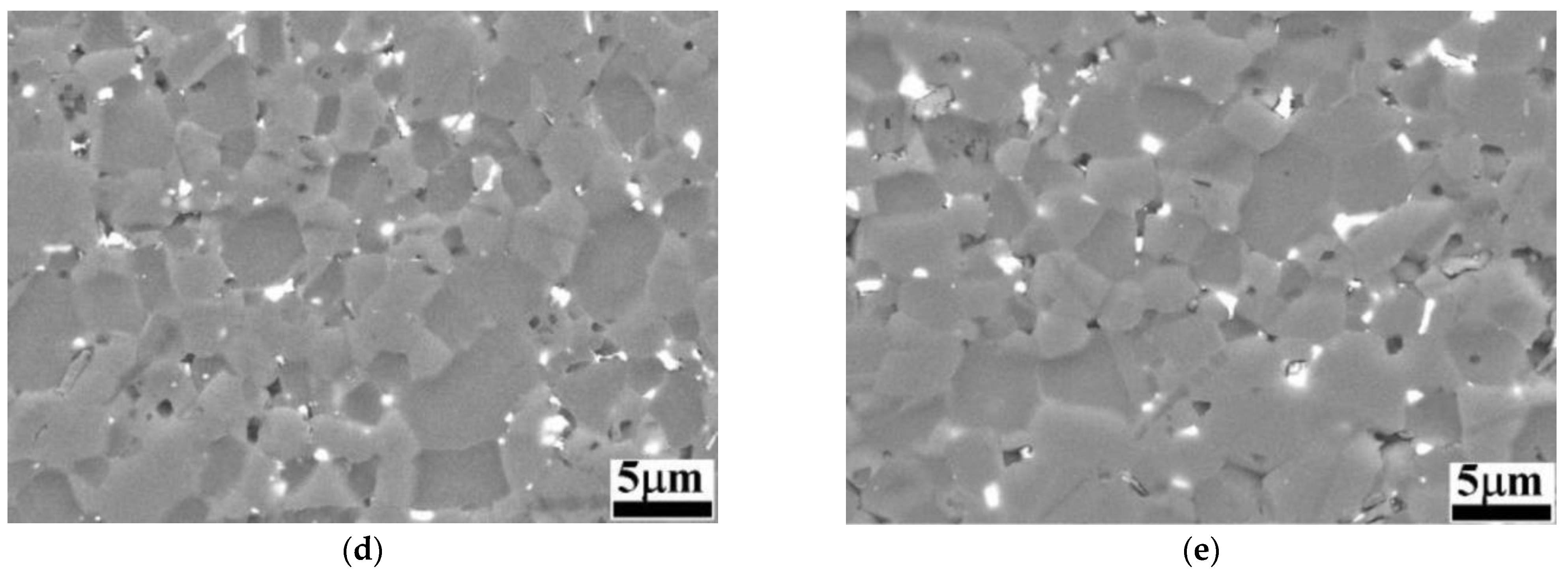
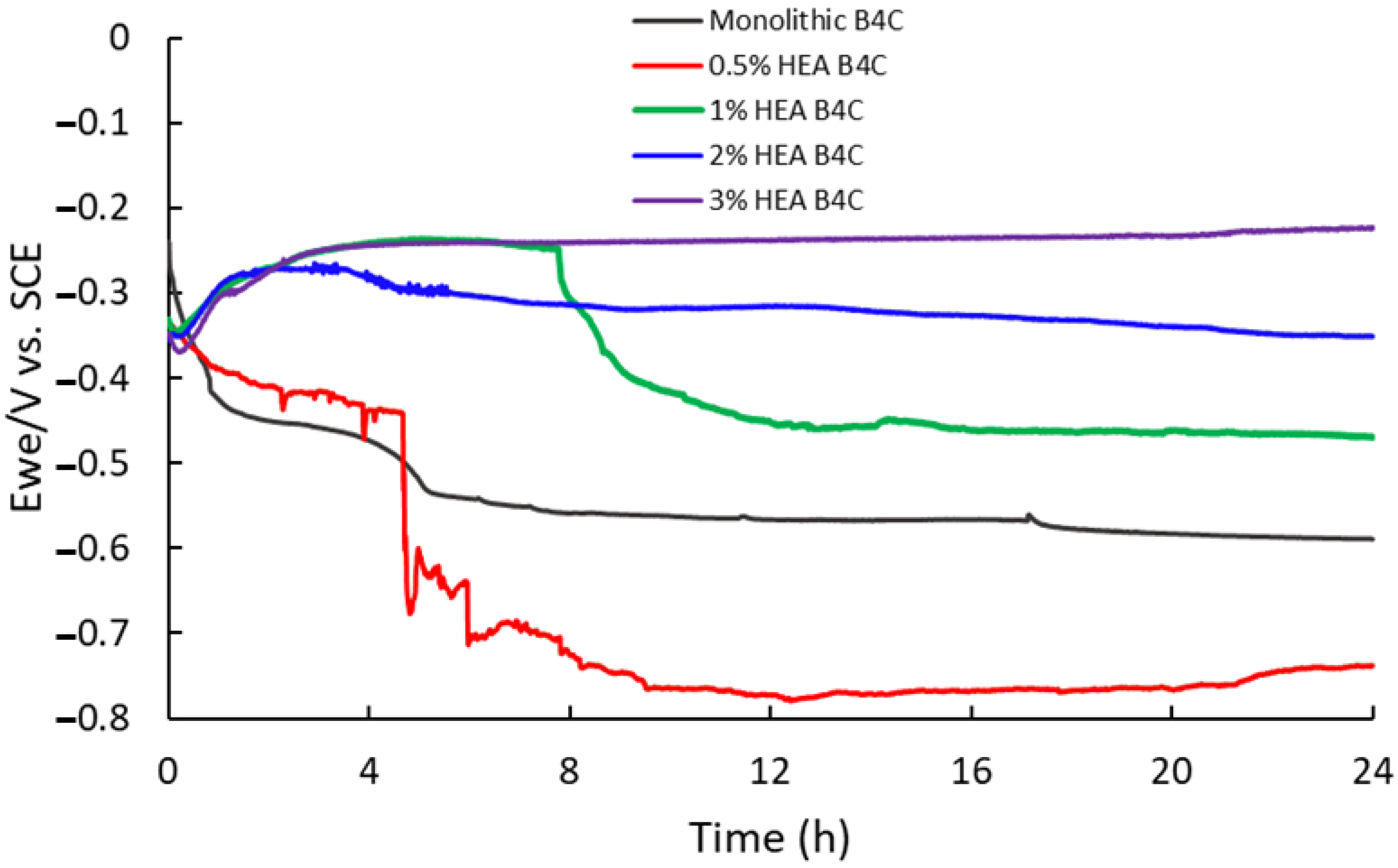
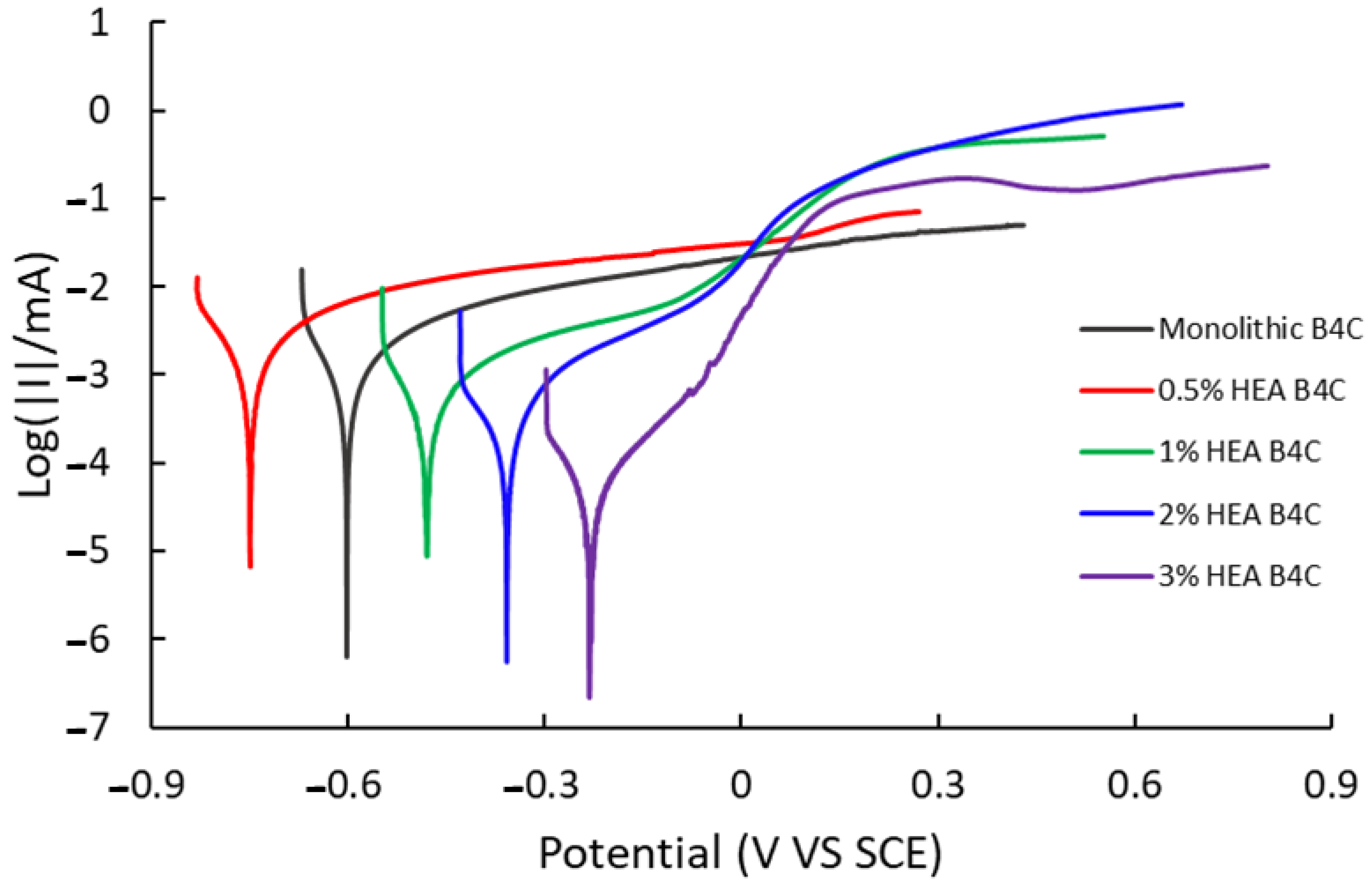
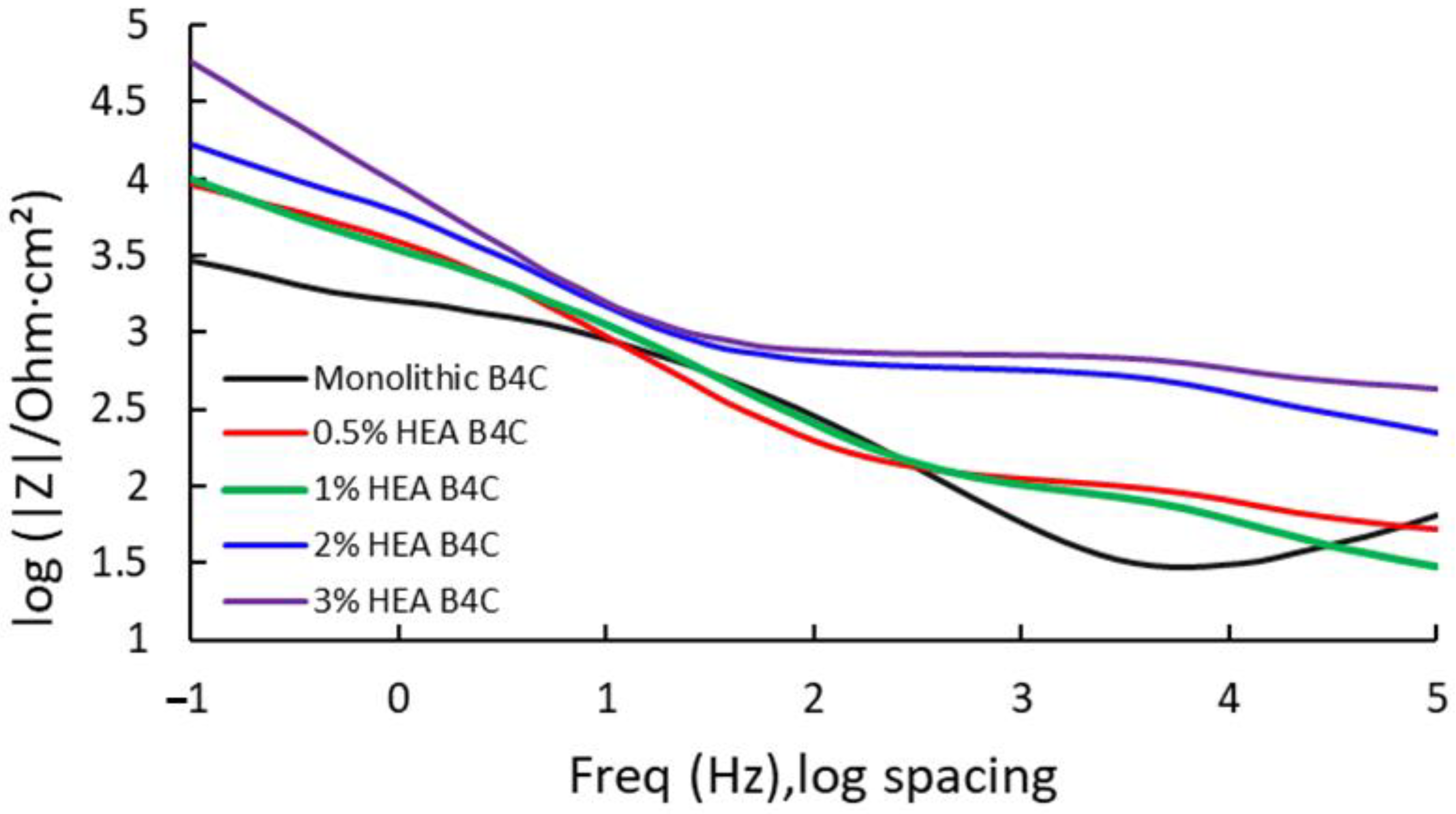

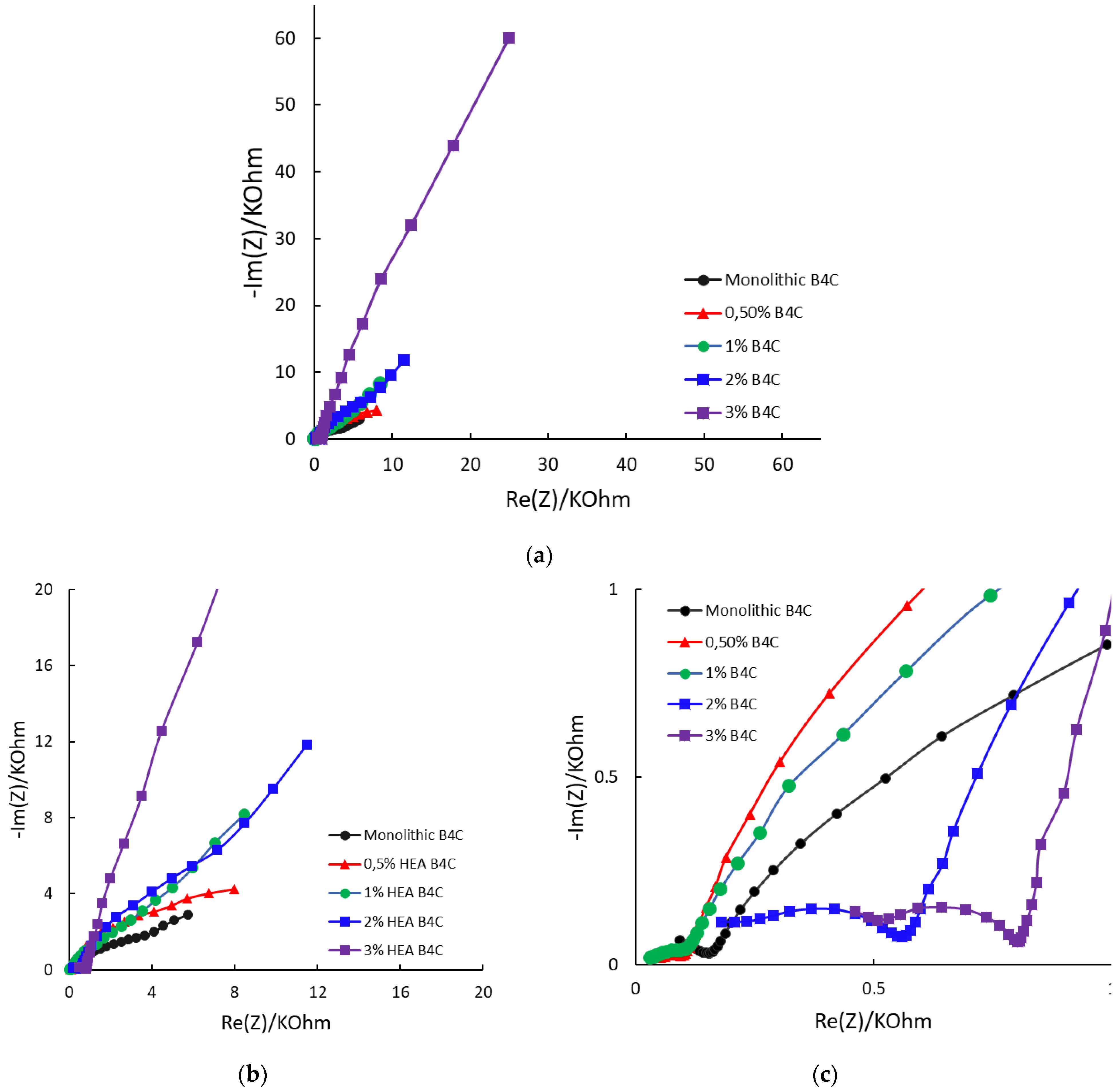
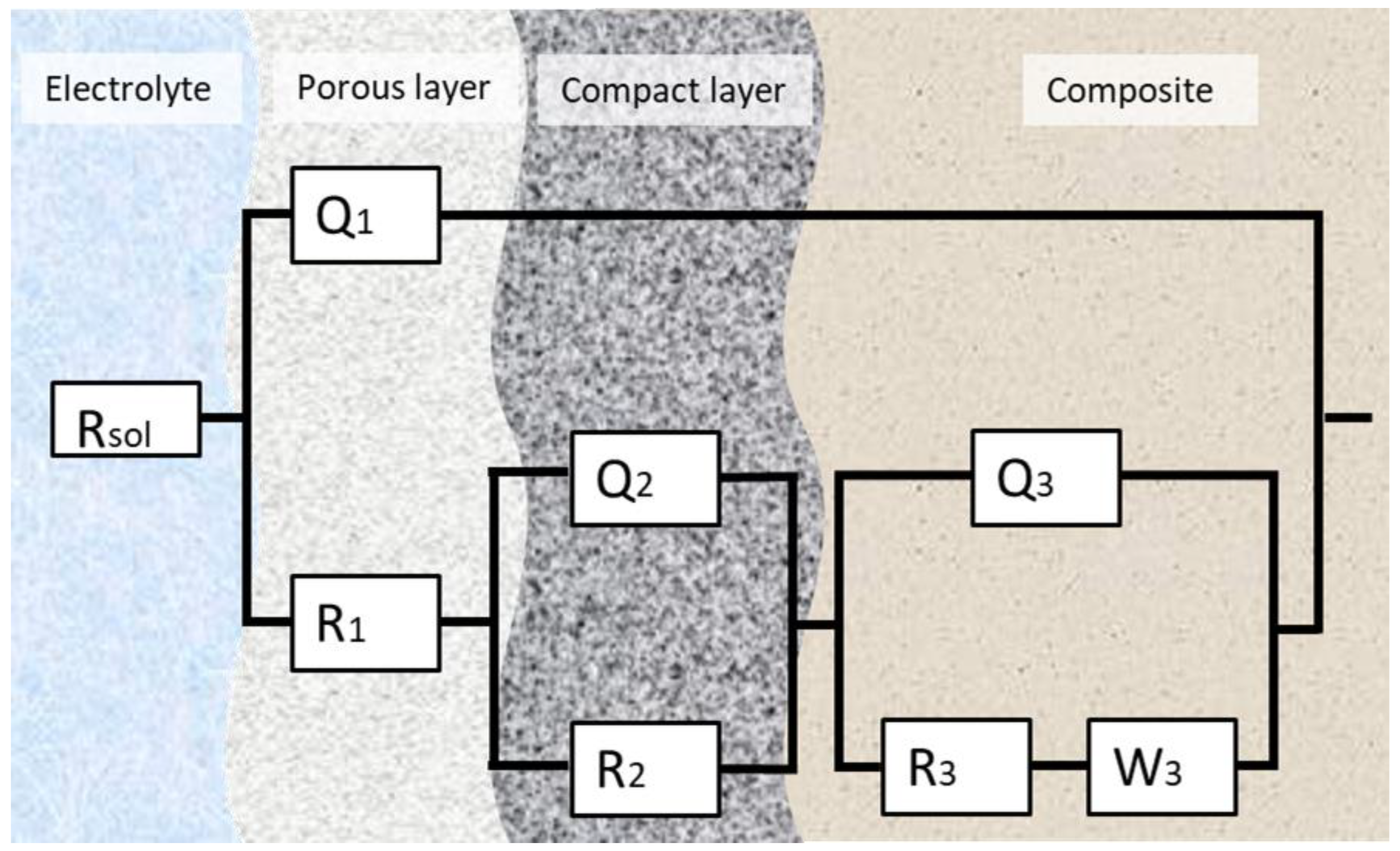
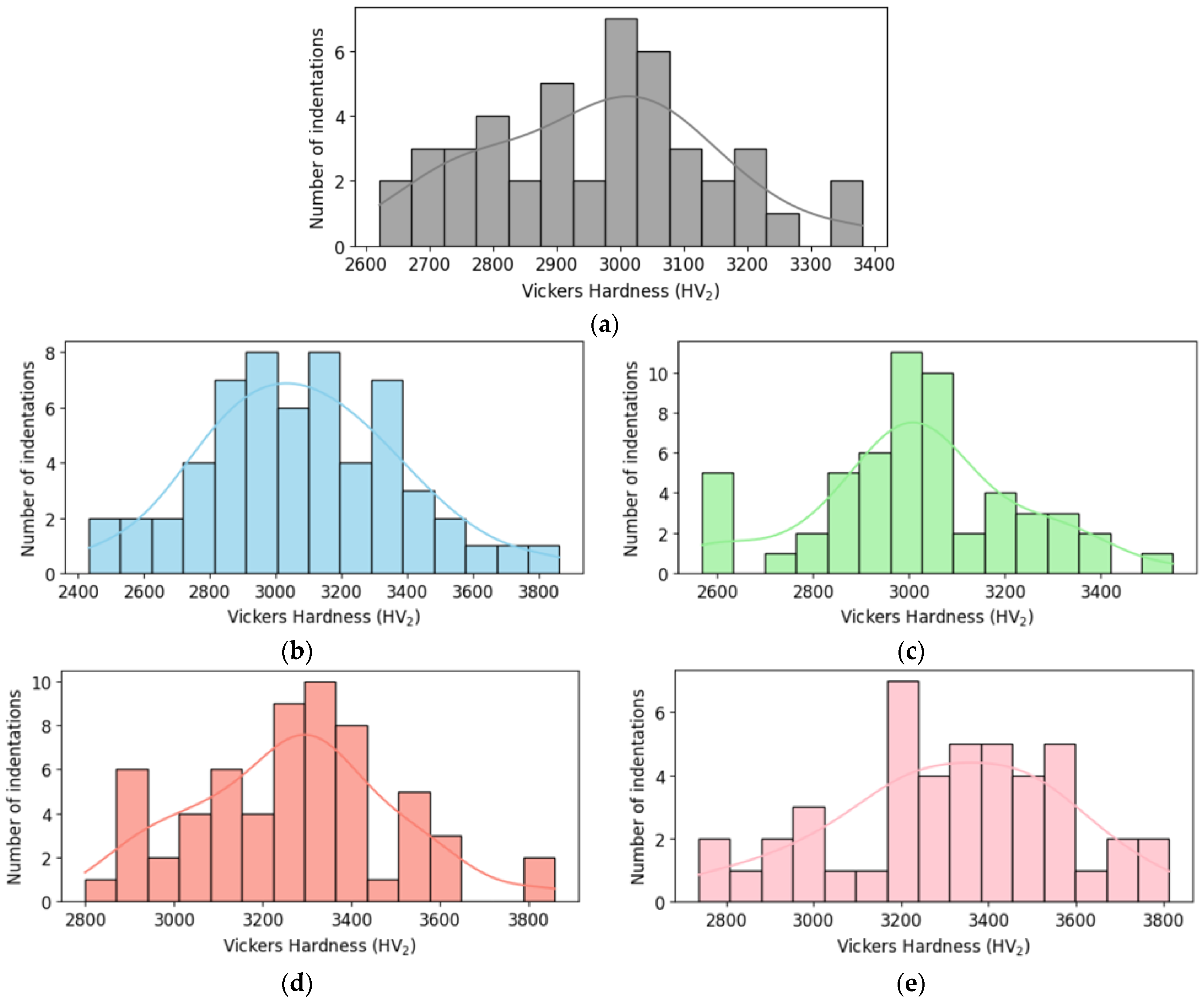
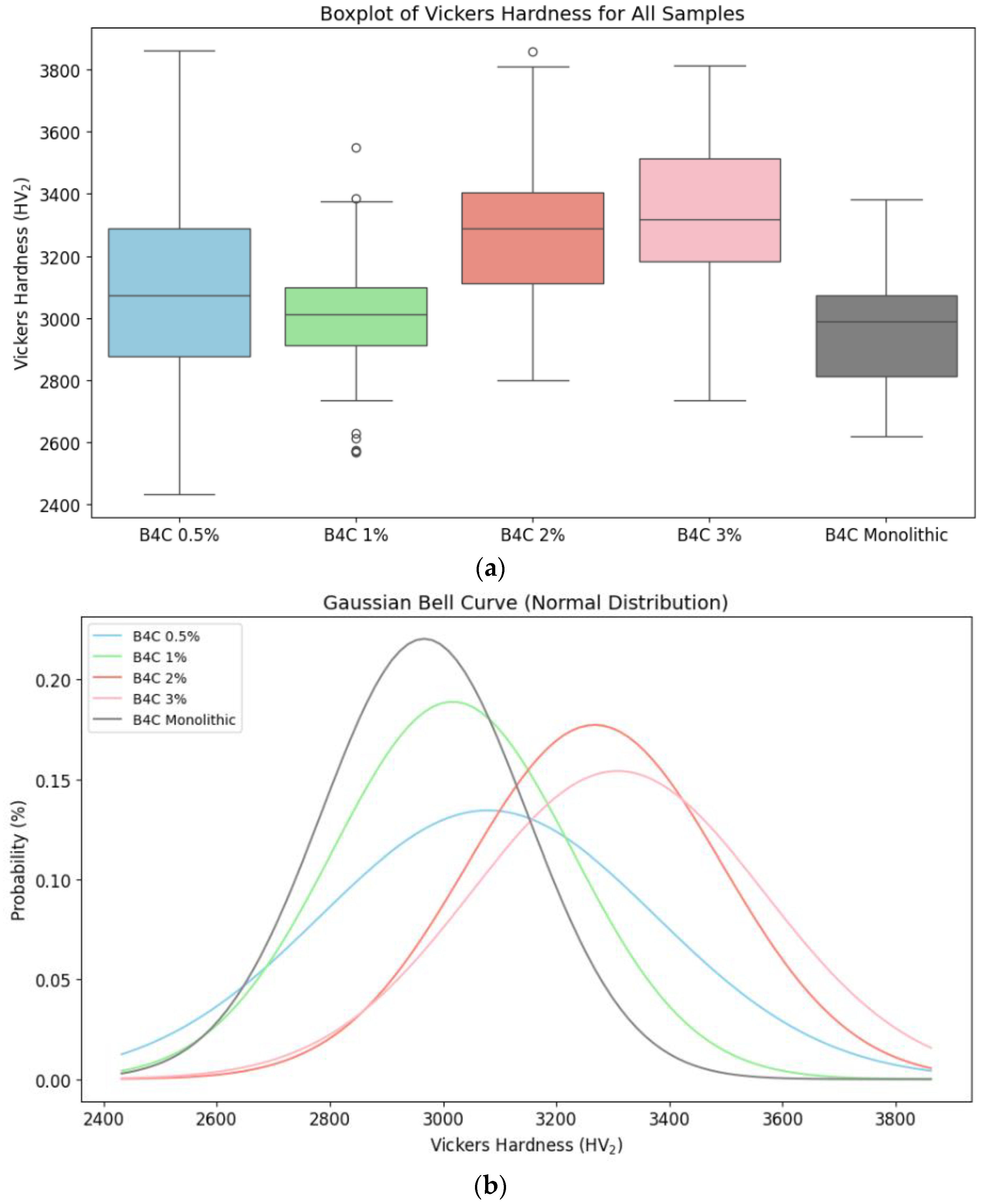
| Parameters | Monolithic B4C | 0.5% HEA B4C | 1% HEA B4C | 2% HEA B4C | 3% HEA B4C |
|---|---|---|---|---|---|
| Ecorr (mV vs. Ref) | −600.665 | −749.920 | −478.421 | −357.533 | −230.693 |
| Icorr (µA/cm2) | 0.296 | 0.834 | 0.161 | 0.111 | 0.041 |
| βc (mV) | 49.7 | 84.2 | 55.9 | 77.0 | 91.1 |
| βa (mV) | 65.6 | 108.4 | 66.3 | 60.3 | 125.2 |
| Equivalent weight (g/eq) | 3.946 | 3.963 | 3.980 | 4.014 | 4.049 |
| Measured density (g/cm3) | 2.43 ± 0.02 | 2.49 ± 0.01 | 2.54 ± 0.01 | 2.61 ± 0.02 | 2.66 ± 0.02 |
| Surface (cm2) | 0.996 | 1.035 | 0.843 | 0.935 | 0.898 |
| Corrosion rate (mpy) | 62.158 × 10−3 | 165.183 × 10−3 | 38.544 × 10−3 | 23.516 × 10−3 | 8.951 × 10−3 |
| Parameters | Monolithic B4C | 0.5% HEA B4C | 1% HEA B4C | 2% HEA B4C | 3% HEA B4C |
|---|---|---|---|---|---|
| Y1 (S·sn/cm2) | 4.472 × 10−8 | 5.218 × 10−5 | 4.927 × 10−5 | 8.268 × 10−9 | 1.001 × 10−8 |
| n1 | 0.876 | 0.460 | 0.516 | 0.940 | 0.856 |
| R1 (ohm·cm2) | 147.3 | 120.4 | 115.1 | 226.9 | 378.6 |
| Y2 (S·sn/cm2) | 2.302 × 10−14 | 1.200 × 10−4 | 2.617 × 10−5 | 5.700 × 10−7 | 1.226 × 10−7 |
| n2 | 0.999 | 0.772 | 0.968 | 0.797 | 0.968 |
| R2 (ohm·cm2) | 2.635 × 10−3 | 13.910 | 1.398 | 317.2 | 209.8 |
| Y3 (S·sn/cm2) | 3.284 × 10−5 | 1.972 × 10−5 | 8.002 × 10−6 | 2.118 × 10−5 | 2.061 × 10−5 |
| n3 | 0.8 | 0.948 | 0.987 | 0.889 | 0.894 |
| R3 (ohm·cm2) | 3.397 | 7.797 | 204.2 | 4.918 | 6.363 |
| YW (S·s5/cm2) | 2.916 × 10−4 | 1.179 × 10−3 | 1.095 × 10−4 | 8.396 × 10−5 | 8.952 × 10−6 |
| Chi-square | 9.92 × 10−4 | 7.75 × 10−4 | 7.02 × 10−4 | 5.18 × 10−4 | 1.22 × 10−4 |
| Statistical Parameters | Hardness (HV2) | ||||
|---|---|---|---|---|---|
| B4C monolithic | B4C 0.5% HEA | B4C 1% HEA | B4C 2% HEA | B4C 3% HEA | |
| Mean | 2966.67 | 3079.52 | 3016.71 | 3268.00 | 3308.57 |
| Median | 2990.00 | 3073.00 | 3011.00 | 3288.00 | 3319.00 |
| Standard deviation | 181.09 | 296.82 | 211.32 | 225.16 | 258.80 |
| Minimum | 2621.00 | 2432.00 | 2568.00 | 2799.00 | 2737.00 |
| Maximum | 3381.00 | 3862.00 | 3550.00 | 3859.00 | 3813.00 |
| Quartile 25 | 2812.00 | 2876.00 | 2913.00 | 3112.00 | 3182.00 |
| Quartile 50 | 2990.00 | 3073.00 | 3011.00 | 3288.00 | 3319.00 |
| Quartile 75 | 3074.00 | 3288.75 | 3100.00 | 3405.00 | 3514.00 |
Disclaimer/Publisher’s Note: The statements, opinions and data contained in all publications are solely those of the individual author(s) and contributor(s) and not of MDPI and/or the editor(s). MDPI and/or the editor(s) disclaim responsibility for any injury to people or property resulting from any ideas, methods, instructions or products referred to in the content. |
© 2025 by the authors. Licensee MDPI, Basel, Switzerland. This article is an open access article distributed under the terms and conditions of the Creative Commons Attribution (CC BY) license (https://creativecommons.org/licenses/by/4.0/).
Share and Cite
Rico-Cano, A.D.; Mirza-Rosca, J.C.; Ocak, B.C.; Goller, G. Impact of CoCrFeNiMo High-Entropy-Alloy Doping on the Mechanical and Electrochemical Properties of B4C Ceramic. Appl. Sci. 2025, 15, 4859. https://doi.org/10.3390/app15094859
Rico-Cano AD, Mirza-Rosca JC, Ocak BC, Goller G. Impact of CoCrFeNiMo High-Entropy-Alloy Doping on the Mechanical and Electrochemical Properties of B4C Ceramic. Applied Sciences. 2025; 15(9):4859. https://doi.org/10.3390/app15094859
Chicago/Turabian StyleRico-Cano, Alberto Daniel, Julia Claudia Mirza-Rosca, Burak Cagri Ocak, and Gultekin Goller. 2025. "Impact of CoCrFeNiMo High-Entropy-Alloy Doping on the Mechanical and Electrochemical Properties of B4C Ceramic" Applied Sciences 15, no. 9: 4859. https://doi.org/10.3390/app15094859
APA StyleRico-Cano, A. D., Mirza-Rosca, J. C., Ocak, B. C., & Goller, G. (2025). Impact of CoCrFeNiMo High-Entropy-Alloy Doping on the Mechanical and Electrochemical Properties of B4C Ceramic. Applied Sciences, 15(9), 4859. https://doi.org/10.3390/app15094859








